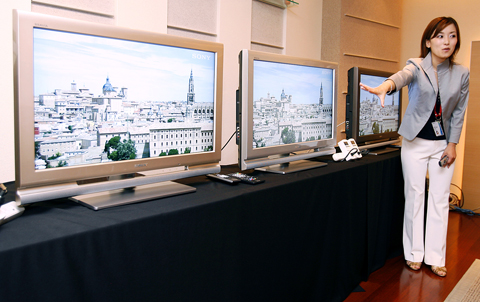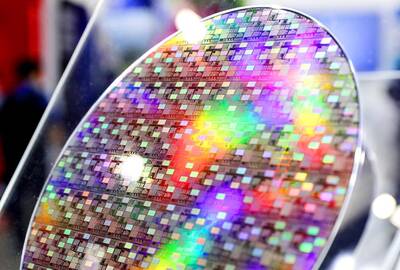Sony's new flat-panel TV consumes less energy than comparable regular models without compromising image quality — the latest in Japanese manufacturers' efforts to woo buyers with green products.
The ¥150,000 (US$1,400) Bravia KDL-32JE1 goes on sale in Japan on July 30, and is planned later for overseas markets although dates and other details aren’t decided, Sony Corp’s Emi Nagahara said yesterday.
In a demonstration at Tokyo headquarters, a watt-counter attached to the new 32-inch Bravia consumed 82 watts of energy to show a Blu-ray disc image of a Spanish city on its liquid crystal display.

PHOTO: AP
A comparable regular model that cost about ¥10,000 less required 125 watts of energy to show the exact same image.
Sony achieved the energy savings by developing a brighter back light and better filtering that delivers light more efficiently, officials said. Both models have liquid crystal displays and high-definition digital broadcast features.
Compared to an old-style TV with a cathode-ray tube (CRT) monitor, the new TV consumes about 70 percent less energy a year.
By consuming less energy, the new “green” TV reduces carbon dioxide emissions totaling 79kg a year, equivalent to the amount consumed by about six cedar trees, it said.
Consumers also save on their utility bill. In Japan, the green TV delivers about ¥4,300 in savings in electricity payments a year compared with an old-style CRT TV, Sony said.

WAITING GAME: The US has so far only offered a ‘best rate tariff,’ which officials assume is about 15 percent, the same as Japan, a person familiar with the matter said Taiwan and the US have completed “technical consultations” regarding tariffs and a finalized rate is expected to be released soon, Executive Yuan spokeswoman Michelle Lee (李慧芝) told a news conference yesterday, as a 90-day pause on US President Donald Trump’s “reciprocal” tariffs is set to expire today. The two countries have reached a “certain degree of consensus” on issues such as tariffs, nontariff trade barriers, trade facilitation, supply chain resilience and economic security, Lee said. They also discussed opportunities for cooperation, investment and procurement, she said. A joint statement is still being negotiated and would be released once the US government has made

‘CRUDE’: The potential countermeasure is in response to South Africa renaming Taiwan’s representative offices and the insistence that it move out of Pretoria Taiwan is considering banning exports of semiconductors to South Africa after the latter unilaterally downgraded and changed the names of Taiwan’s two representative offices, the Ministry of Foreign Affairs (MOFA) said yesterday. On Monday last week, the South African Department of International Relations and Cooperation unilaterally released a statement saying that, as of April 1, the Taipei Liaison Offices in Pretoria and Cape Town had been renamed the “Taipei Commercial Office in Johannesburg” and the “Taipei Commercial Office in Cape Town.” Citing UN General Assembly Resolution 2758, it said that South Africa “recognizes the People’s Republic of China (PRC) as the sole

NEW GEAR: On top of the new Tien Kung IV air defense missiles, the military is expected to place orders for a new combat vehicle next year for delivery in 2028 Mass production of Tien Kung IV (Sky Bow IV) missiles is expected to start next year, with plans to order 122 pods, the Ministry of National Defense’s (MND) latest list of regulated military material showed. The document said that the armed forces would obtain 46 pods of the air defense missiles next year and 76 pods the year after that. The Tien Kung IV is designed to intercept cruise missiles and ballistic missiles to an altitude of 70km, compared with the 60km maximum altitude achieved by the Missile Segment Enhancement variant of PAC-3 systems. A defense source said yesterday that the number of

Taiwanese exports to the US are to be subject to a 20 percent tariff starting on Thursday next week, according to an executive order signed by US President Donald Trump yesterday. The 20 percent levy was the same as the tariffs imposed on Vietnam, Sri Lanka and Bangladesh by Trump. It was higher than the tariffs imposed on Japan, South Korea and the EU (15 percent), as well as those on the Philippines (19 percent). A Taiwan official with knowledge of the matter said it is a "phased" tariff rate, and negotiations would continue. "Once negotiations conclude, Taiwan will obtain a better